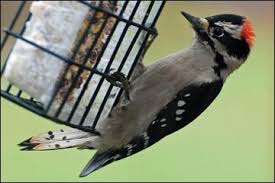This was a popular bird on the family farm near Havana, North Dakota. My Mom was the bird lover of our family and seemed to know the sounds especially as macular degeneration took her sight away and she relied on her hearing to know which birds were around her feeders. They were especially frequent in the winter so suet was always available for them. My Mother passed away in April 2016 from Stage 4 lung cancer and Stage 4 COPD and I miss her every day. No matter the struggles she faced, she always had a positive outlook and I hope she installed that in me.
My intent with these caches along this I-94 route is to share an image and information pertaining to different birds that are common to our state and region. You are looking for a camo preform that will be hanging or sticking. Make sure cap is secure so they continue to be weather proof. Some of these areas are more busy than others. Make sure you park off the road and be aware of muggles.Please let me know if maintenance is needed. Please also keep off the ground so these caches can be winter friendly. If you find one of my signature items, it is yours to keep. If you already have found one of my signature items, please leave for someone who has not received one. Please bring your own writing tool. One is provided with the initial placement but you know how that goes.If you are new to geocaching, please check out the geocacher's etiquette for this lifelong family-friendly hobby. http://www.geocreed.info/
Downy Woodpecker
![]()
Dryobates pubescens
 Conservation status: Very common and widespread, with no evidence of population declines.
Conservation status: Very common and widespread, with no evidence of population declines.
Family Woodpeckers
Habitat: Forests, woodlots, willows, river groves, orchards, shade trees. Found in wide variety of habitats, from wilderness areas to second-growth woods to suburban yards, but generally favors deciduous trees. In far north and in mountains (areas dominated by conifers), restricted to groves of deciduous trees such as aspens or willows.
The smallest woodpecker in North America, common and widespread, although it avoids the arid southwest. In the east this is the most familiar member of the family, readily entering towns and city parks, coming to backyard bird feeders. Its small size makes it versatile, and it may forage on weed stalks as well as in large trees. In winter it often joins roving mixed flocks of chickadees, nuthatches, and other birds in the woods.
Feeding Behavior
Can forage not only on trunks and major limbs of trees but also on minor branches and twigs (often climbing about acrobatically and hanging upside down), as well as on shrubs and weed stalks. Male and female forage differently at times, but this varies with place and season. Feeding on trees, does more tapping and excavating in winter, more gleaning from surface in summer.
Eggs/Young
4-5, sometimes 3-6. White. Incubation is by both sexes, about 12 days. Young: Both parents bring billfuls of insects to feed the nestlings. Young leave the nest about 20-25 days after hatching, may follow parents around for a few weeks thereafter. 1 brood per year, possibly 2 in south.